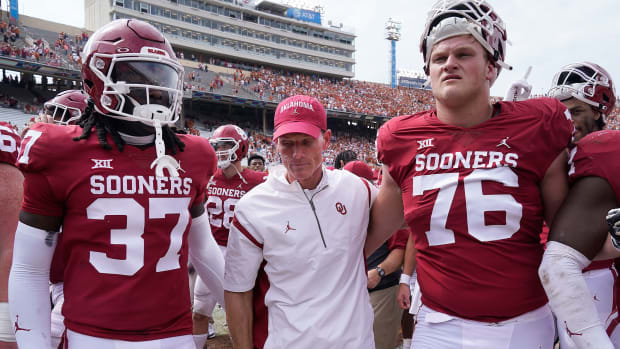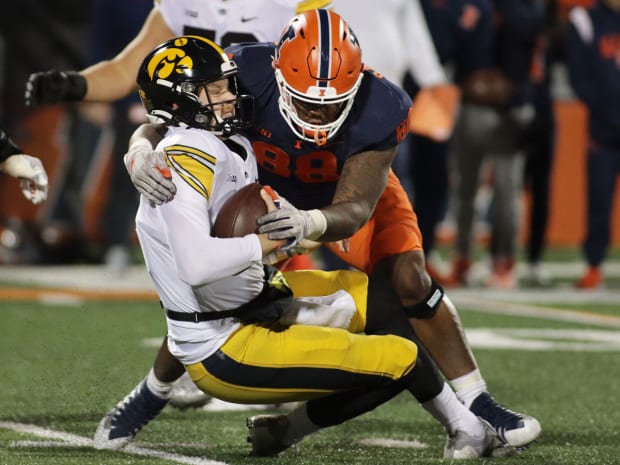Forty names, games, teams and minutiae making news in college football (unnecessary, game-losing throws into the end zone sold separately in Tallahassee):
MORE DASH: Loaded Weekend | Heisman Race
SECOND QUARTER
RED RIVER REVERBERATIONS
We’ll get to Texas, and an intriguing scenario, in a moment. But discussion emanating from Dallas on Saturday has to start with the complete free fall of Oklahoma (11) in the span of three jaw-dropping weeks.
The Sooners came strutting away from a blowout of Nebraska with a 3–0 record and a No. 6 ranking, hearing hosannas from every direction. The praise overlooked the fact that the Cornhuskers were in disarray after firing their coach and weren’t very good to begin with. Such is the power of a Brand Name beating another Brand Name, no matter how dated those labels might have been.
It was a heady moment. In coping with the trauma of being jilted by Lincoln Riley, the We Don’t Need Him Kool-Aid had been consumed in large quantities during the offseason and the first three weeks by Sooner Nation. We don’t need him anyway. He was slowly ruining the program. Too soft. No defense. Brent Venables will make us better than Riley ever could. As flimsy evidence, a fan media post showing Venables and strength coach Jerry Schmidt clapping and looking intense before the Nebraska game was trumpeted as evidence of a “different” culture.
Well, it’s different, all right.

LM Otero/AP
Since beating Nebraska, Oklahoma has lost three straight for the first time since 1998. It has been outscored 145–58. The 49–0 pole-axing in the Cotton Bowl against the arch-rival Longhorns was the worst shutout loss in program history. Amid this kind of carnage, the question has to be asked: Is career defensive coordinator Venables nothing but a dark-room guy?
In football parlance, a “dark-room guy” is a coach who excels in the film room, lights off, preparing a gameplan. The head coach’s job extends far beyond that, into the light, into the public, into organizing and overseeing an entire sprawling program. It can be too big for some career assistants, with some notable examples at blueblood programs.
Charlie Weis was a dark-room guy who, after some initial success, flopped (profitably) at Notre Dame. Mike Shula was a dark-room guy who was fired at Alabama to make room for Nick Saban (pretty good move). Will Muschamp at Florida, Ray Goff at Georgia, Derek Dooley at Tennessee—dark-room guys, all.
Is Venables next to join that list? Too early to say. But this three-game stretch is bad enough to conjure up memories of John Blake and Howard Schnellenberger, the two coaches who oversaw the last Sooner Dark Period, from 1995 to ’98. Blake got three seasons on the job, but Schnellenberger was one-and-done, fired after going 5-5-1 and ending that season with a three-game losing streak that is similar to this one, being outscored 98–10.
It seems highly improbable that Venables wouldn’t get at least one more season to prove himself, even if this one continues its current tailspin. (There were off-field reasons that contributed to Schnellenberger being ousted after a year.) He’s recruiting well, and the level of transition after Riley left and took the star quarterback and wide receiver with him has to be factored in (even if the fans dismissed it).
But at 3–3, Oklahoma already has its most losses in a season since 2014. And everyone knows what’s looming in a couple of years—Southeastern Conference membership. Athletic director Joe Castiglione assuredly will want his football program functioning at a high level when it’s time for that transition. Venables has some work to do to prove he’s the guy who can get the Sooners there in good order.
On the flip side, Texas looked strong behind the best performance yet by quarterback Quinn Ewers (12). The one-time top recruit in the nation came back from a shoulder injury to complete 21 of 31 passes for 289 yards and four touchdowns, and that gives rise to a provocative question: If Texas wins out, going 11–2 and winning the Big 12, should the Longhorns get College Football Playoff consideration?
In the nine-year history of the CFP, we’ve never had a two-loss team. Things can change, but there is a good chance we’ll have at least four Power 5 teams with zero or one loss come Selection Sunday. But if Texas goes undefeated in games when Ewers is healthy, could it get an injury mulligan?
With Ewers missing the final three quarters against Alabama, the Horns lost by a point. He was also out for the three-point loss at Texas Tech. It’s a pretty big leap to assume Texas can win out from here—especially in a deep Big 12—but if it does, and gets some help from other teams losing, the Texas Injury Mulligan Political Action Committee could kick into gear. (The school has not been shy about politicking for postseason favoritism in the past.)
QUARTERBACK HEALTH, QUARTERBACK DEPTH—THEY MATTER
With the transfer portal reducing quality depth at the most important position, you can see the effect of a QB injury at the wrong time. Take Oklahoma, for instance, which was without starter Dillon Gabriel (13) against Texas, and offensive coordinator Jeff Lebby basically panicked.
The Sooners resorted to the Wildcat offense for significant stretches, including a precious jump pass by running back Eric Gray that was intercepted in the red zone. Starter Davis Beville, a former third-stringer at Pittsburgh, was 6-of-12 for 38 yards and an interception. How Oklahoma entered the game with a combination of Beville and the Wildcat as its best QB option is staggering.
But Oklahoma is hardly the only program hurting for depth at QB. North Carolina State went into a shell after a third-quarter injury to star Devin Leary (14) Saturday, attempting just two passes the rest of the game—one of them by a running back to backup QB Jack Chambers for a five-yard loss. The Wolfpack somehow escaped with a win over Florida State, thanks to a disastrous interception in the end zone by Jordan Travis when the Seminoles were in range for the winning field goal in the final minute.

Ron Johnson/USA TODAY Sports
Clearly, Iowa (15) cannot be shamed into even testing its QB depth behind starter Spencer Petras. In a towering display of stubbornness and arrogance, Team Ferentz (head coach Kirk and nepotism all-star assistant Brian) has had Petras throw every pass this season—with disastrous results. The latest: zero touchdowns, two field goals, 222 total yards in a 9–6 loss to Illinois that dropped a team with elite defense and special teams to 3–3 on the season.
Petras is the lowest-rated passer in the Big Ten, and Iowa is 125th nationally in pass efficiency—lowest of any Power 5 team. It is 131st (dead last) in total offense and 127th in scoring offense—with the caveat that 18 of its 88 points have been scored directly by the defense. Petras has had a pedestrian four years at Iowa, but Team Ferentz wasn’t interested in a portal option to upgrade. (In fact, it did almost nothing offensively in the portal, despite some significant receiver losses there.)
It must be asked: What’s wrong with giving any other QB on the roster a single series to see if he can provide a spark? It can’t get worse, only better. But Iowa isn’t willing to try.
In contradiction to all recent history, Kansas (16) has both a star QB and a quality backup. When Jalon Daniels was injured Saturday against TCU, the Jayhawks kept matching points in a shootout thanks to backup Jason Bean (16-of-24 for 262 yards and four touchdowns passing, plus 34 yards rushing). And it must be pointed out that TCU (17) star QB Max Duggan wasn’t the opening-day starter for the Horned Frogs—he stepped in when Chandler Morris was injured and Sonny Dykes’s offense has rolled.
Watch college football live with fuboTV: Start a free trial today!
At Notre Dame, a season on the brink has been revived in no small part by the progression of Drew Pyne (18). When starter Tyler Buchner went down with a shoulder injury (so many QB shoulder injuries this season), it forced Pyne into duty in the ugly loss to Marshall. His first start, against Cal, was not pretty at times—coordinator Tommy Rees f-bombing him on the phone from the press box was memorable—but the Fighting Irish are 3–0 with him at the helm. Pyne’s efficiency rating has improved every start, from 157 against Cal to 171 against North Carolina to 185 Saturday against BYU.
At Louisville, all hope appeared to be lost when 40-game starter Malik Cunningham was ruled out Saturday against Virginia. Brock Domann (19) got his first start, and his first pass was an interception that helped put the Cardinals in a 10–0 hole. With fans busy firing Scott Satterfield on social media—in part due to allegedly not recruiting a quality backup QB to Cunningham—Domann turned everything around. He finished the game with 275 passing yards and 71 rushing yards, leading Louisville to a 34–17 victory that temporarily lessened the heat on its coach.
Across the state at Kentucky (20), the lack of immediately playable depth behind injured starter Will Levis was glaring in a 24–14 home upset loss to South Carolina—the first time the Gamecocks had won in Lexington in a decade. Backup Kaiya Sheron threw for 114 of his 178 yards on a window-dressing touchdown drive late in the fourth quarter while trailing 24–7. (Yes, he threw for 114 yards on a single drive due to 41 yards in losses from sacks and penalties.)
Levis watched the game in a walking boot. If he’s not back for Mississippi State on Saturday, the Wildcats could be looking at a three-game losing streak after rising into the top 10.







